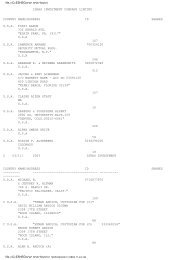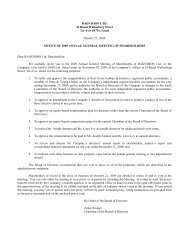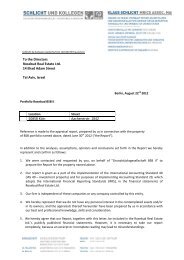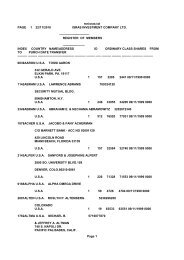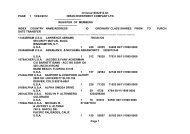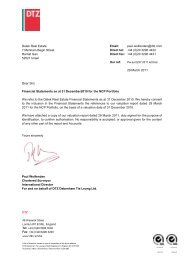XTL BIOPHARMACEUTICALS LTD.
XTL BIOPHARMACEUTICALS LTD.
XTL BIOPHARMACEUTICALS LTD.
You also want an ePaper? Increase the reach of your titles
YUMPU automatically turns print PDFs into web optimized ePapers that Google loves.
Due to the highly competitive nature of the market for acute pain drugs, and the FDA requirement to complete two repeat-dosing clinical trials<br />
in two different acute pain indications, no further studies in acute pain are planned.<br />
Bicifadine has been further evaluated in three Phase 3 trials in chronic lower back pain, or CLBP. The primary efficacy endpoint in these trials<br />
was the change in pain severity rating score between baseline and the end of dosing. In these trials, Bicifadine was safe and generally well tolerated,<br />
but did not show a statistically significant effect relative to placebo on the primary endpoint of the study at any of the doses tested.<br />
We believe that the failure of Bicifadine in the CLBP trials was a result of the inherent heterogeneity of the studied patient population (i.e. the<br />
varying causes of CLBP pain), uncontrolled physical activities in what is largely an activity-dependent pain indication, and a high placebo response.<br />
We believe that by re-directing the development of Bicifadine away from the novel indications in acute and chronic pain toward a proven area<br />
of efficacy of SNRI’s in the treatment of neuropathic pain, Bicifadine could be successfully developed for neuropathic pain, possibly offering a<br />
differentiated efficacy and safety profile based on the drug’s emphasis on norepinephrine reuptake inhibition.<br />
Development Status<br />
The Phase 2b trial that was initiated in September 2007 is aimed at demonstrating the efficacy of Bicifadine in diabetic neuropathic pain,<br />
using a study design that is similar to the successful registration trials of Cymbalta®, a member of the SNRI class that is approved for this indication,<br />
and other approved agents for neuropathic pain.<br />
The Phase 2b study is a randomized, double-blind, placebo-controlled study comparing 200mg 3x/day (tid) and 400mg 3x/day (tid) of<br />
Bicifadine versus placebo, with a 1:1:1 randomization between the three arms, in patients with diabetic neuropathic pain. The Phase 2b study is<br />
designed to enroll approximately 336 patients. Approximately 45 clinical centers in the United States, Europe, Israel and India are participating in the<br />
study. Following randomization, all patients enter a two week titration period to allow them to gradually escalate up to their target treatment dose. This<br />
is then followed by a twelve week steady-state treatment period at the target treatment dose. The primary endpoint of the study is to compare the<br />
efficacy of each of the two active doses of Bicifadine (200mg tid and 400mg tid) versus placebo in reduction of pain associated with diabetic<br />
neuropathy, at baseline (at the time of randomization) versus week 14 (week twelve of the steady-state phase). Pain will be measured based on a 24hour<br />
pain rating using the eleven point Pain Intensity Numeric Rating Scale (formerly referred to as the LIKERT scale).<br />
In addition, in January 2008, we initiated an open-label variable-dose trial assessing the safety of Bicifadine in patients with diabetic<br />
neuropathic pain (the “open label study”). Eligible patients for the open label study will have completed all study visits of the Phase 2b clinical trial.<br />
Subjects who satisfy all inclusion and exclusion criteria will be titrated to a dosage of 600 mg/day (200 mg tid). Depending upon efficacy and<br />
tolerability the dosage can be progressively increased to 1200 mg/day (400 mg tid). The dosage can be altered throughout the trial but may not go<br />
below 600 mg/day (200 tid) or above 1200 mg/day (400 tid). The open label study is designed to enroll approximately 240 patients.<br />
DOS<br />
Market Opportunity<br />
We have been developing the DOS program for the treatment of hepatitis C. Chronic hepatitis C is a serious life-threatening disease which<br />
affects around 170 to 200 million people worldwide, according to a Datamonitor report from April 2005. We estimate that between eight to 10 million<br />
of these people reside in the US, Europe and Japan. According to the BioSeeker Group, 20% to 30% of chronic hepatitis patients will eventually<br />
develop progressive liver disease that may lead to decomposition of the liver or hepatocellular carcinoma (liver cancer). According to the National<br />
Digestive Diseases Information Clearing House, each year 10,000 to 12,000 people die from HCV in the US alone. The Centers for Disease Control, or<br />
CDC, predicts, that by the end of this decade, the number of deaths due to HCV in the US will surpass the number of deaths due to AIDS.<br />
According to the PharmaDD, the worldwide market for the treatment of chronic HCV in 2005 was estimated at $3 billion and consists entirely<br />
of Interferon-based treatments. Interferon alpha was first approved for use against chronic hepatitis C in 1991. At present, the optimal regimen appears<br />
to be a 24 or 48 week course of the combination of Pegylated-Interferon and Ribavirin. In studies done at the St. Louis University School of Medicine,<br />
a 24 week course of this combination therapy yields a sustained response rate of approximately 40% to 45% in patients with genotype 1 (the most<br />
prevalent genotype in the western world according to the CDC) and a better sustained response with a 48 week course.<br />
19



